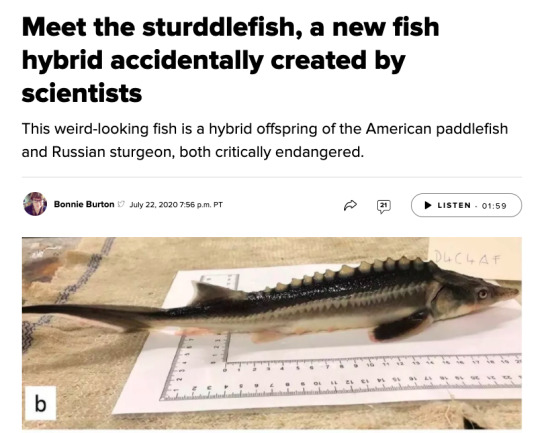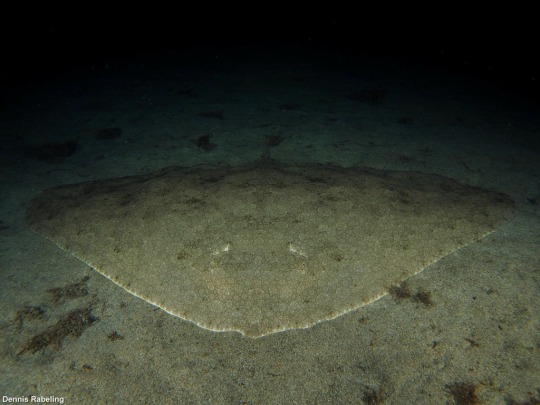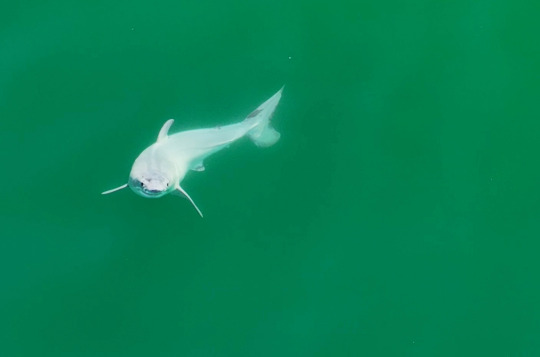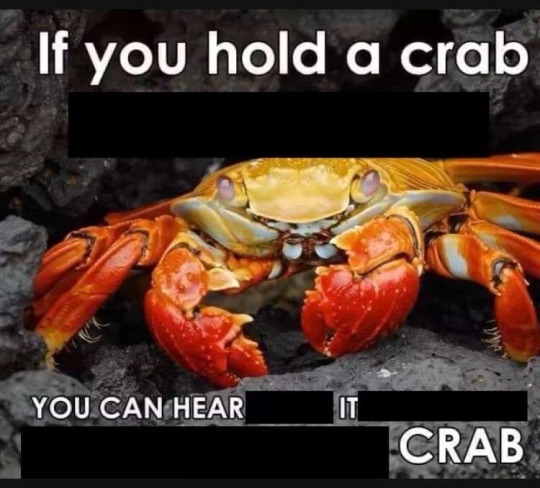#fish science
Explore tagged Tumblr posts
Text
I really try to avoid fact checking people in public comment sections on the internet, but sadly this time I couldn't resist.
There was a reel on Facebook explaining the "sad" reason why cetaceans in human care often receive ice. It's because they're given "dead fish" you see, and these frozen thawed fish contain less moisture than the live fish they eat in the wild, so the ice helps prevent dehydration.
First of all, this is half true. The other half is that many cetaceans just love getting ice.
Supplemental hydration can also include gelatin and squid. The latter two are not unique to cetaceans btw. Squid and specially formulated gelatin based foods are also used in many fish diets in part to provide additional moisture. They also count as enrichment, depending on the context.
In any event, this creator thinks it's sad... that caretakers are providing their dolphins additional hydration? What, does he also think it's sad that they get vitamins? Reptile keepers regularly dust their animals' food with calcium to make sure they don't get metabolic bone disease. Is that also sad? These things are standard zoological practices, not signs of neglect. Wouldn't it be sadder if they didn't do that?
(Reason #423 why framing matters).
"But it's not natural!"
Neither is running on a treadmill, but that doesn't mean it's bad for you. Also, I'm pretty sure ICE is one of the most natural things you could use....
"Well why can't they just give them live fish!?"
Because the logistics of sustaining a live colony for such a purpose would be an expensive nightmare. Do you know how many pounds of fish these animals need to eat in a day? Using them as an occasional form of enrichment might be feasible, but on the regular? Just. No! Tell me you don't know how fish care works without telling me you don't know how fish care works!
It's cruel to the fish, for the same reason that it's cruel to feed snakes live food (assuming they aren't picky eaters). Fish are not just props, they are live animals that can experience stress and pain!
Freezing the fish helps keep it safe to eat.
"Why not just release them back into the wild?"
Because that would also be cruel since they wouldn't know how to survive. Next question.
"How do they get dehydrated when they live in water!?"
Oh man. Oh man oh man.
Cetaceans get most of their hydration from their diet. A quick google search indicted that they can drink some salt water, though I don't know how true that is, and to be clear, their kidneys are likely much more efficient at filtering out salt than ours (someone who knows more about this, please feel free to correct me). Regardless, most of their hydration comes from their food. Lack of food leads to dehydration, both in captivity and in the wild.
But there was one guy who said that dolphins in captivity can't drink the water because it's chlorinated. This is not true. The residual amounts of chlorine left after their water passes through filtration is no higher than what is in your tap water.
(Btw, this is another reason why live fish aren't typically used, because you don't house fish in systems that use chlorine, even in small amounts).
When I pointed this out to the guy, his response was that "most of their diet contains water from the exact same source."
To his credit, he did back down when I pointed out that this was wrong. But come my friends! As a fish person, let me explain to you why this is not correct!
Fish blood chemistry is not the same as the ambient water around them. They would not be able to maintain homeostasis otherwise. You see, their gills and kidneys help them osmoregulate.
Freshwater fish blood contains more salts than the surrounding freshwater, which means the via osmosis, water will enter the body, and unless they can compensate for this, the fish will swell up like a balloon, lose necessary salts, and basically drown. So what do they do? Their kidneys produce large amounts of dilute urine get rid of this extra water. Meanwhile, chloride cells in their gills take up ions from the water to transport into their blood.
Saltwater fish, however, have the opposite problem. Their blood has less salts than the surrounding water, so they need to get rid of extra salt. How? Well, they actually do drink the saltwater, and then their kidneys help filter out the extra salt. They basically produce very concentrated urine. But the kidneys cannot do this alone, so the chloride cells in their gills also help by basically working in reverse. They move extra ions out of the blood.
Elasmobranchs, crustaceans, mollusks and other marine mammals that may also make up some cetacean diets will have their own methods of osmoregulation.
All of this is to say, no, eating saltwater animals does not mean you're literally consuming ocean water, as these organisms have specific mechanisms for filtering out the excess salts.
This is, btw, why you can't just put a freshwater fish in saltwater or vice versa. They will die. Nor is this unique to fish, most organisms adapted for one environment don't thrive in the other.* Case in point: we cannot drink salt water, because our kidneys cannot handle that.
But some animals can! Take the salmon for instance. They hatch in freshwater environments, then move to saltwater, and then back when spawning season comes. How do they do this? Well, there are specific environmental/developmental triggers that cause their bodies to start osmoregulating in reverse. This does not happen instantaneously, however. They need time to adjust. They will migrate to brackish water, and allow their bodies a few days to adjust before continuing.
Some species of fish have higher tolerances for wider ranges of salinity/total dissolved solids (TDS) than others. Fluctuating these levels can actually trigger spawning in some species too! Discus, for instance, can be maintained in relatively harder freshwater than what they'd experience in the wild. But for breeding purposes, it's recommended to use softer water with lower a TDS. Given that discus can be more finicky, however, any of these adjustments should be made gradually.
On the other hand, there might be another species where a more sudden change is beneficial. Tropical fish native to floodplains that will experience sudden onsets of flooding from the rainy season, for instance, may need precisely that sudden rush of freshwater with lower pH and TDS to trigger spawning. Even if spawning isn't the end goal, simulating these seasonal fluctuations can be a very effective form of naturalistic enrichment!
....Oh dear, I went on a very nerdy tangent, because SCIENCE!!!! Enjoy.
*this can actually be taken advantage of in certain treatment contexts! Saltwater aquarists will sometimes do what is called a "freshwater dip", where the saltwater fish is very briefly immersed in freshwater to help rid them of harmful external parasites or bacteria. Usually, it's used when fish are first brought into quarantine. It's not 100% effective on its own, but it's one of the many tools in an aquarist's arsenal. Oh! This can also be used on sea turtles in some rescue situations! Again... SCIENCE!!! >:D
#cetaceans#animal welfare#fish#fish science#fish are cool#stop dissing my fish!!!#their welfare matters too!#correcting misinformation#I'm more familiar with freshwater than saltwater fish#so any saltwater aquarists#please feel free to chime in and correct me on anything#and dolphin keepers#please correct me as well as I'm not a cetacean expert
198 notes
·
View notes
Text

Diaphonized fish !
Via Pinterest
#fish anatomy#fishblr#fishposting#fish science#I mostly post alive and swimming fish#I hope the girls don’t mind#I liked the colors :)
104 notes
·
View notes
Text
Here are some simple explanations for the flora and fauna in the basic oceanic zones:
Sunlight Zone: Hee hoo cute fish, plants, and whales breaching :)
Twilight Zone: Ooo, spoopy fish, but they're so tiny, and there's a plant somewhere!
Midnight Zone: Hey look! Tuna! THEYREINMYDREAMSTHEYREINMYDREAMSTHEYREINMYDREAMS
Abyssal Zone: Seems scary with the dark water, but there's so many cute things like Dumbo Octopods <3
4 notes
·
View notes
Text
rn im majoring in forestry with a focus in forest biology, but might want to switch to aquatic biology. this is a ridiculously important thing to be asking on tumblr but i cannot even begin to decide. both would be super fucking interesting and have the same number of required credits
pros and cons below the cut
pros:
get to work with wetlands more
still doing stuff with plants and animals
the program is centered on freshwater conservation which i really like
was thinking of doing a water resources minor anyway, this would be easier to get all the credits
electives for both are super flexible so i could really focus on what interests me
watershed conservation is generally better paying than forestry
better to prepare for a ms in limnology
could stay in the greater great lakes region long-term
cons:
calculus i and ii
organic chemistry i and ii
i really fucking hate math
generally harder classes
might not go for an ms anyway
#college#studyblr#bachelors degree#undergraduate#bachelor of science#environmental science#environmental studies#environmetalists#ecology#forestry#forest tech#epa#forest service#aquatic science#wildlife and fisheries#aquatics and fisheries#fish science#limnology#freshwater fish#freshwater#great lakes#lake ontario#lake erie#lake huron#lake michigan#lake superior#new york#pennsylvania#ohio#michigan
4 notes
·
View notes
Text
Someone explain why fish makes my head hurt
Doesn’t matter if i like how it tastes or not
Any fish makes my head hurt.
Except tuna in sushi bc it’s not much
I am not allergic i have no allergies i am unkillable
#food#help#fish#?????#how do i tag this so smart people see it#science#or smth#i’m sorry if that’s wrong i’m struggling with this and my mum never believes me#fish science#fish moment#food science#????!!!!!???
3 notes
·
View notes
Text
Okay but did they ever prove which one it was

one of the best academic paper titles
#fish#science#fish science#mri#study#studies#scientific research#posts that make me laugh#posts that are interesting
116K notes
·
View notes
Text

The shape of a fish's caudal tail can tell you a lot about how fast the fish moves! A rounded tail is the slowest and a lunate tail is the fastest! The lunate tail has the most optimal ratio of high thrust and low draw, making it the fastest.
Ichthyology Notes 2/?
#marine biology#science#biology#wildlife#marine life#ocean#animals#marine ecology#animal facts#fun facts#fish#fishies#zoology#fish anatomy#anatomy#fish facts#ichthyology
43K notes
·
View notes
Note

I found this wet floor sign with some suspiciously dna looking writing on it
String identified: CAT CA TAGCT T A t t g t c a g tg t
Closest match: Sphaeramia orbicularis genome assembly, chromosome: 4 Common name: Chubby Cardinal

(image source)
#tumblr genetics#genetics#biology#science#asks#requests#sent to me#artnmak#fish#ocean#chubby cardinal#<- cute common name for a fish that looks like it's seen the face of god
5K notes
·
View notes
Text

47K notes
·
View notes
Text
me after reading the name of the fish hybrid: *fingers crossed* please let it be half fish half apple strudel, please let it be half fish half ap...
NEW FISH JUST DROPPED

140K notes
·
View notes
Text
as funny as it is to say, "there's no such thing as a fish" is not actually true
"science doesn't know what a fish is" is really not true
"fish" is not a monophyletic category. there is no common ancestor of everything that we call a "fish," and none of the things that we don't
"fish" is a paraphyletic category -- and a useful one! marine biologists use it! "fish" describes a general body plan and lifestyle. it is useful to be able to talk about coelacanths and tuna in a shared category, though coelacanths are more closely related to us than to tuna.
where this bugs me is the repetition of the idea that "scientists" are hidebound and uncreative, unable to comprehend anything that doesn't conform to a specific idea of categorization -- when this is fundamentally untrue! we know perfectly well what a "fish" is. the fact that it's a paraphyletic group is only confounding to pop science, as a funny factoid, not to anyone who actually understands what a paraphyletic group is.
#bird original#science#pop science#fish#marine biology#biology#scicomm#putting this in main tags bc it came up recently and has been itching in my brain ever since
9K notes
·
View notes
Text
I love butterfly rays because half of the images of them online come in two varieties and it’s

a) a baybey!

b) I know what you are.
#been sitting in my drafts forever#marine biology#marine bio#biology#science#marine biology memes#ray#butterfly ray#chondrichthyes#cartilaginous fish#creatures#sea creatures#cryptid#marine biodiversity#marine bio meme#meme#science meme#bio#ocean lover#ocean#thalassaphobia#thalassaphobia cw#post#also ty guys for 170+ followers!! :.)
92K notes
·
View notes
Text




Incredible images from neurological studies done on zebrafish
Top to bottom: cover of Journal of neuroscience 2012, image displays how the brain and spinal chord work together to control complex movements; 2009 image examines serotonergic raphe neurons; 2020 image of Zebrafish embryo under a fluorescent microscope; 2019 image of first interactive cell atlas for the brain of zebrafish
#fishblr#fishposting#fish irl#fish science#fish#zebrafish#science#scientific illustration#neuroscience
44 notes
·
View notes
Text

Exciting news for the cute shark lovers of the world! We finally have a recorded sighting of a baby great white shark, likely only a few hours old.
The question of where great white sharks give birth still remains a mystery to this day but this footage may suggest the coasts of California, where the footage was taken, are a site where these sharks give birth.
#marine animals#marine biology#shark#sharks#shark facts#fish facts#sharkblr#fish#fun facts#science#science news#great white shark
9K notes
·
View notes
Text
Flight of the mini-mantas! These little devils are mobulas, which are cousins of the more famous manta ray. They are known to migrate together in enormous schools of hundreds or even tens of thousands of individuals (especially off of Baja California Sur), and have no spines like a stingray. As such they are completely harmless, and beautiful to watch underwater.
#mobula#ray#marine biology#marine bio#biology#zoology#animals#nature#ocean#marine science#ocean life#chondrichthyes#elasmos#elasmobranchs#marine ecology#marine conservation#conservation#fish
1K notes
·
View notes
